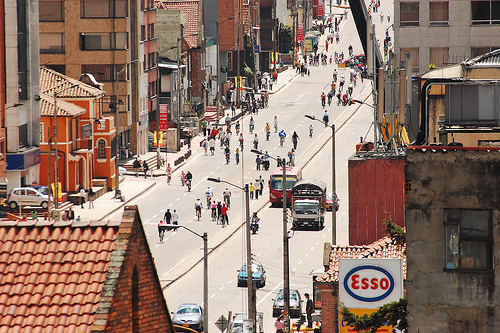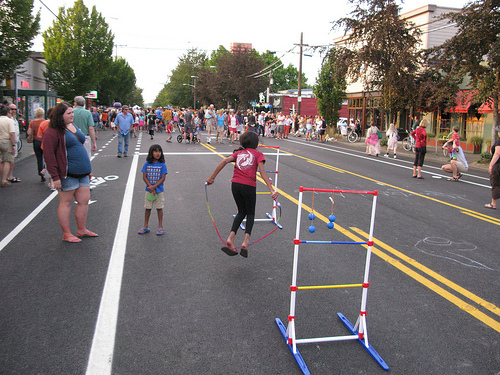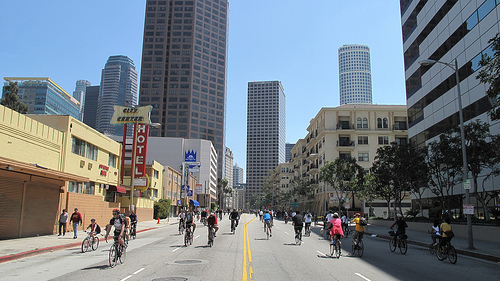Alexandria’s streets could be for people instead of cars, at least some of the time
Cities all over the world are trying out the concept of open streets, where a temporary event closes a street to cars so people can enjoy the space by doing things like walking, riding bikes, or rollerskating. Alexandria could join the fun.
Open streets typically feature miles of closed streets including a commercial-district “main street.” People wander between shops and things like public health kiosks without being squeezed onto sidewalks.
In 2010, two organizations— the Alliance for Biking and Walking and The Street Plans Collaborative— partnered to create the Open Streets Project, the goal being to make more open streets initiatives happen in a wider array of places by sharing information about them.
Open streets have been around a long time and are becoming more popular
The open streets movement has its roots in Bogotá, Columbia, where “ciclovias,” streets temporarily closed to cars to encourage biking and walking, are opened on Sundays and holidays, beginning in the 1970s. In Bogotá, with its notorious traffic jams, the cyclovia provides relief from crowding, pollution and stress.
Today, open streets happen all over the country. In New York and Seattle, these are called Summer Streets. Seattle also does an event called Bicycle Sunday a few times per year. That event simply opens an attractive street to car-free recreation, similar to closing Beach Drive in DC each weekend.
Los Angeles does four CycLAvias each year, each in a different part of town and featuring 5-10 miles of open streets.
In San Francisco, Sunday Streets began when bicycling advocates partnered with a supportive mayor and city staff. It is currently operated by Livable City, a nonprofit advocacy group. CycLAvias in Los Angelese began with a similar grass-roots effort. Both events attract numerous sponsors, including the local transit agency.
Philadelphia got a taste of car-free streets when the Pope visited last month. The 4.7 square mile car-free security zone was so popular that Mayor Michael Nutter, and mayoral candidate Jim Kenney, each promised a smaller-scale repeat of “Popen Streets.”
“We’re celebrating our open streets,” one citizen told the New York Times. “Blissed-out pedestrians are walking down the middle of roads,” reported Philadelphia magazine. The effect on nearby traffic was minimal: the predicted traffic “pope-amageddon” never materialized.
Alexandria could have open streets events
For a city like Alexandria to try an open streets initiative, we would need an organization willing to lead it. The Open Streets Guide, a product of the Open Streets Project, describes best practices for would-be organizers. It also points users toward the annual Open Streets Summit, which provides training and networking.

The annual Halloween arade on Mount Vernon Avenue in Alexandria: an open street with a costume requirement. Photo by the author.
One might imagine closing all of Mount Vernon Avenue (two miles) along with the commercial portions of East and West Glebe (one mile). This would bring attention to the many shops in Del Ray and Chirilagua. Similarly, opening Fairfax, Lee and Union Streets (1.5 miles each) and part of King Street (one mile) would introduce people to the shops of North Old Town and show off King Street in a new light. Grass-roots organizing could help make all this happen.
Like Art On The Avenue in Del Ray, open streets initiatives bring visitors. With open streets, though, organizers need not provide elaborate street-fair entertainment (though they might get a sponsor to do it). The opportunity to enjoy a car-free street is enticing enough that people make their own entertainment.
There is also no need to draw huge crowds. If the streets become too crowded for impromptu fun, such as the ice cream vendor “Popesicle Bike Race” in Philadelphia, the fun is spoiled.
There are fair concerns about open streets events, but we can sooth people’s fears
The aim of Open Streets is to create new possibilities for public space, not shut them down. Separate from concerns over traffic disruptions during the event, some citizens worry that open streets events would lead to bans on cars— or, put differently, that Old Town might get a car-free zone. I’ve heard these concerns from the aging and disability communities, for example. My friend Dan Kulund, formerly of the Alexandria Commission on Aging, once told me that, even in a car-free zone, motorized transportation must be kept available for those who are truly unable to walk.
Both now and in the long run, though, I don’t think an open streets initiative in Alexandria would lead to any kind of permanent ban of cars. After all, the events only last for a few hours.
Without fear of being run down by a car, people move about freely, as in a pre-automobile cityscape. Actually, there’s no need to imagine— you can see if for yourself in the YouTube video, “A Trip Down Market Street:”
Recorded in 1906, this film shows the view from a streetcar in San Francisco. People move about in every direction on foot, horse, bicycle and car, with no conflicts and with no dangerous speeding. This video illustrates streetlife before “jaywalking” was invented, a “jay” being a person utterly lacking in sophistication.
Imagine a street festival, only less crowded, bringing citizens out to enjoy the shops and restaurants of our beautiful city. People in streets and cafes are both the spectators and entertainment. Perhaps not the most sophisticated of entertainments, open streets nevertheless sound quite civilized to me.




